#sustained growth
Text
India's Q3 GDP Skyrockets to 8.4%, Surpassing Expectations: Official Figures
India's Q3 GDP data for the October-December 2023 quarter reveals a significant surge, with GDP growing by 8.4% year-on-year, compared to 4.3% recorded the previous year. This outstrips analyst expectations, who had anticipated a slower growth rate ....
India’s economy has witnessed a remarkable resurgence in the third quarter of the fiscal year, with the GDP growth rate soaring to 8.4%. This exceptional performance has not only outstripped earlier forecasts but also underscores the resilience and potential of the Indian economy.
India's Q3 GDP data for the October-December 2023 quarter reveals a significant surge, with GDP growing by 8.4%…

View On WordPress
0 notes
Text

Global Expansion Strategies for Businesses
Embark on a journey to take your business beyond borders. This guide provides insights into the intricacies of global expansion, from market research to cultural considerations, equipping you with the tools to thrive in international markets.
0 notes
Text
"In an unprecedented step to preserve and maintain the most carbon-rich elements of U.S. forests in an era of climate change, President Joe Biden’s administration last week proposed to end commercially driven logging of old-growth trees in National Forests.
Secretary of Agriculture Tom Vilsack, who oversees the U.S. Forest Service, issued a Notice of Intent to amend the land management plans of all 128 National Forests to prioritize old-growth conservation and recognize the oldest trees’ unique role in carbon storage.
It would be the first nationwide amendment to forest plans in the 118-year history of the Forest Service, where local rangers typically have the final word on how to balance forests’ role in watershed, wildlife and recreation with the agency’s mandate to maintain a “sustained yield” of timber.
“Old-growth forests are a vital part of our ecosystems and a special cultural resource,” Vilsack said in a statement accompanying the notice. “This clear direction will help our old-growth forests thrive across our shared landscape.”
But initial responses from both environmentalists and the logging industry suggest that the plan does not resolve the conflict between the Forest Service’s traditional role of administering the “products and services” of public lands—especially timber—and the challenges the agency now faces due to climate change. National Forests hold most of the nation’s mature and old-growth trees, and therefore, its greatest stores of forest carbon, but that resource is under growing pressure from wildfire, insects, disease and other impacts of warming.
Views could not be more polarized on how the National Forests should be managed in light of the growing risks.
National and local environmental advocates have been urging the Biden administration to adopt a new policy emphasizing preservation in National Forests, treating them as a strategic reserve of carbon. Although they praised the old-growth proposal as an “historic” step, they want to see protection extended to “mature” forests, those dominated by trees roughly 80 to 150 years old, which are a far larger portion of the National Forests. As old-growth trees are lost, which can happen rapidly due to megafires and other assaults, they argue that the Forest Service should be ensuring there are fully developed trees on the landscape to take their place...
The Biden administration’s new proposal seeks to take a middle ground, establishing protection for the oldest trees under its stewardship while allowing exceptions to reduce fuel hazards, protect public health and safety and other purposes. And the Forest Service is seeking public comment through Feb. 2 (Note: That's the official page for the proposed rule, but for some reason you can only submit comments through the forest service website - so do that here!) on the proposal as well as other steps needed to manage its lands to retain mature and old-growth forests over time, particularly in light of climate change.
If the Forest Service were to put in place nationwide protections for both mature and old-growth forests, it would close off most of the National Forests to logging. In an inventory concluded earlier this year in response to a Biden executive order, the Forest Service found that 24.7 million acres, or 17 percent, of its 144.3 million acres of forest are old-growth, while 68.1 million acres, or 47 percent, are mature."
-via Inside Climate News, December 20, 2023
-
Note: This proposed rule is current up for public comment! If you're in the US, you can go here to file an official comment telling the Biden administration how much you support this proposal - and that you think it should be extended to mature forests!
Official public comments really DO matter. You can leave a comment on this proposal here until February 2nd.
#united states#us politics#conservation#climate change#sustainability#forests#old growth forest#national forest#carbon emissions#climate action#climate crisis#forest service#biden#biden administration#public comment#good news#hope#it took me soooo long to hunt down the actual public comment link#by which I mean like 10 minutes but like#that's too long! especially considering I am way better at navigating language and bureaucratic websites like this#than A LOT of people#why tf can't you just comment on the Official Website For Public Commenting?#aka regulations.gov#baffling#anyway the good news is I did find it so pls do go ahead and submit a comment if you can
3K notes
·
View notes
Text
Brainwash yourself with good habits. You need to do it the way you would train a dog - fetch the stick and get a treat.
I love listening to music but I also wanted to start listening to podcasts. I have to go to work everyday, and I prefer to drive myself to work and back.
I know that if I make myself listen to podcasts both drives, the habit will last not more than 3 days.
But if I make myself listen to a podcast on the way to work; and listen to my favourite music on the way back home to de-stress and relax; now that’s a healthy compromise. And it works for the long term.
The same goes with social media. I deleted all social media from my phone. I don’t have Facebook, Instagram, or even tumblr on my phone. The YouTube account that I keep on my phone has been very consciously kept; I only allow the algorithm to show me educational stuff like podcasts, history videos, news, psychology, stuff like that. Absolutely no entertainment. I keep all my social media (and my “fun” YouTube account which is basically Korean mukbangs and all sorts of useless beauty hauls that I honestly love to watch) on another device - my iPad, which I use for work. I check out what’s happening on tumblr or YouTube or Pinterest when it’s my lunch break or a coffee break. That’s another healthy compromise that works for me.
Going cold turkey with anything - stopping something addictive like smoking or drinking or suddenly starting a plethora of new habits- doesn’t work. You’ve restricted your mind and body so much that you keep remember the good old days where you drank like a whale and sat on the couch watching rubbish and you glamorise, romanticise and reminisce those times. Now you’re in that dangerous red zone where you know that if you see that bottle or the packet of chips, your body is going to reach for it before your mind can intervene.
Aim for long-term, sustainable albeit small habits, rather than complex overnight habits.
#c suite#powerful woman#strong women#ceo aesthetic#personal growth#that girl#productivity#getting your life together#balance#habits#sustainable#how to be disciplined#discipline#inconsistency#Social media#social media detox
2K notes
·
View notes
Text
So fucking sick of the "infinite growth/everything needs to be the next biggest hit or we're axing it" mantra of capitalism.
It's not enough for a company to be successful and sustainable, it needs to have record profits every single quarter or the shareholders and investors start panicking. It's not enough for a new tv series to have good ratings and loyal fanbase, it needs to be as big as Stranger Things or Game of Thrones or it's getting canceled. Products that are a tiny bit more expensive to make but are loved by loyal customers have their ingredients switched with shitty, inferior, yet cheaper versions that save a little money at the expense of some of the customers leaving.
This entire ideology is so self-destructive but who cares, it made a handful of people a tiny bit richer in the short term, right?
#like I feel like I am SO MUCH smarter than the average capitalist#I would simply go with sustainable growth and happy customers#fuck capitalism#anti capitalism#eat the rich#rant
201 notes
·
View notes
Note
Actually considering Tori has a more limited food source in the reborn au, does this mean she ends up shorter than 5 ft?
i wouldn't make her even shorter :( she's suffered enough :(
but actually i don't think the food thing is severe/persistent enough to affect her. i didn't mean to imply the clan is having severe food limitations, just that they're relying more on stuff they can get from the immediate area rather than things they would normally get from somewhere else, and the war makes even that harder as it stretches on and on. i didn't get into this very deep, but the relationship the clan has with the surrounding area is that they protect it (and do services similar to the missions villages take, like go finding missing people or help with labor) and then they get various types of support in return. this would include financial support but also supplies like meat and vegetables. so when the war started, they weren't really set up to self-sustain. they had some chickens and gardening, but it's not like they weren't regularly getting meat/eggs/etc from other sources, so they'e not set up to feed the whole clan.
that being said, they're ninja in their home turf and they know how to get food from what they have. cicadas are actually very nutritionally dense, even if they're not your favorite protein source, for example. tori isn't going to bed hungry most nights, and this will actually get better once the clans unite
although, yeah, cut rations is a pretty cruel punishment for a child
#in homemade dynamite i am going to make it canon that deidara is a little shorter than he could be from malnutrition#but this is because he graduated early and had to self-sustain himself at a young age with no adult oversight#so he was living off shit like cup noodles during his growth spurt years#deidara @ tori: i can't believe your family nerfed my height#reborn au
35 notes
·
View notes
Text
Peace and love to everyone who is rethinking their actions and maybe regretting cutting dteam off so quickly, but it wont be that easy to earn back my support as a viewer
#all of them have a lot of growth to do and honestly im not here to watch grown adults figure out how to sustain their own morals#especially ppl who wanna preach abt safe spaces for girls while falling for and allowing t.erf rethoric to foster in their spaces#ik its unfair to expect nuance from hashtag gamers but if they choose to reap the benefits of being the ~girl power#then they should also have some basic understanding of some stuff
23 notes
·
View notes
Text
The main goal of degrowth can be best described as making the necessary transition to an environmentally-friendly and sustainable economy in a way that is smart, social, and democratic. Ecological economics, political economics, geography, biology, and political ecology are just some academic disciplines that contribute to the expanding body of knowledge that shapes the discipline of degrowth. Like Keynes and Friedman before them, degrowth economists are keen on not staying in some ivory tower but having a real impact on society.
Supporters of the degrowth approach rely on the growing body of scientific evidence suggesting that continued economic growth dependency leads to gradual collective destruction and impoverishment through the detour of its environmental impact.
Degrowth is in opposition to the idea of “green growth”. Green growth supporters promote environmental awareness and care for humanity but cling to the belief that growth and the damages caused by growth can be decoupled in a timely and sufficient manner. However, multiple studies in top academic journals, such as Nature and Science, have refuted this core assumption thoroughly. Since 2019, when the EEB published its groundbreaking and much-cited report titled “Decoupling Debunked”, the burden of proof concerning decoupling prospects arguably lies with green growthers.
As explained in the “Decoupling Debunked” report, the economy’s carbon intensity should fall 100 times faster than now – an unrealistic number – for green growth to work. In turn, degrowth as a physical necessity is an inconvenient truth that frequently encounters populist resistance and disinformation. As long as we only add renewable energy and do not phase out fossil energy, our existential problem will continue to grow.
[...]
The best available scientific synthesis is increasingly pointing to degrowth as a necessity, from the Intergovernmental Panel on Climate Change (IPCC) for the climate to the Intergovernmental Science-Policy Platform on Biodiversity and Ecosystem Services (IPBES) for biodiversity. A rapid reduction in the most harmful extraction and production is a scientifically proven prerequisite for achieving global sustainability, social justice, and well-being.
78 notes
·
View notes
Text
Let’s Talk About: Earth Bending
Recently, I had some more insight into bending energy and I decided it’s finally time to write a #longpost. I’ve missed doing them.
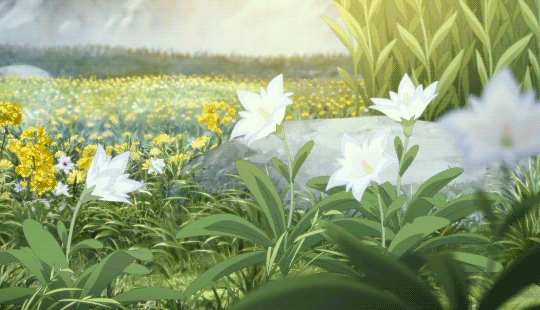
What is Earth Bending?
Earth bending is when you know how to manipulate your own energy and frequency to be able to match that of the earth (soil, sand, the ground). What you’re really doing is working with them on their level. It’s sort of like translating energy.
How do I learn how to bend earth?
When you know how to control your own energy, then you know how to filter outside energy. This process of learning to control your energy is part of how you become an expert of your own energy, from there you can feel which energies aren’t yours and you can feel things come through the frequency line you create. Your hands may tingle when you do this as energy transfers. When you create that connection, you can talk to the earth.
You can feel its energy and listen to what it yearns for. Maui is yearning for joy. It wants its people to find joy on its shores, it needs aloha and its ohana too. I felt it there. On Oahu, the land yearns for water. In some places it felt so dried, I was brought to tears just to water it.
How do I get on the same frequency?
You can create such a powerful connection with the elements when you ask them questions. They hear our cries all the time and we never ask them about themselves. It’s a one sided dynamic. You have to form a relationship with the element.
I stick my hands in the dirt and I ask questions. I caress and play with the sand. I spend time with it and learn about what it wants and how I can help tell people.
My gift as a communicator isn’t just in public relations but also in hearing things people can’t always hear. Talking to that which people think isn’t sentient. How cruel. To diminish the ocean or the sand in that way. Just because things don’t express themselves in a human way, doesn’t mean they aren’t sentient or communicating. That’s how I’m also able to talk to animals and find their frequency. It’s like a radio tuner and you have to get it to the right place for the clearest signal.
Tips for strengthening your bond with the earth:
—bury your hair
—bleed into the soil (a little like a pin prick)
—remove invasive plants
—caress and play with it
—laugh and talk with it
—help it heal (ie plant native plants, help restore the soil, bring the water back)
**do this at a place you spend a lot of time enjoying, give back to that which gives so freely to you**
—Go spend time pouring your love, your life force into it
—plant beautiful plants in an aesthetically pleasing way, help the land gain its confidence and pride back
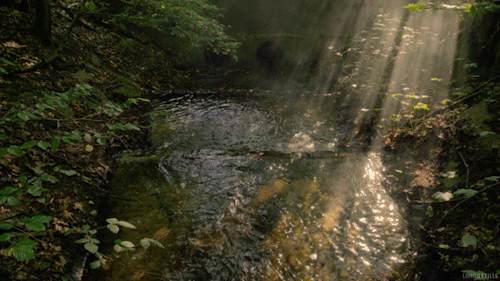
The Land Feels Too
When land is stripped of all its uniqueness (native/endemic plants) and nutrients, it too feels defeated and sad. It needs to be brought back to life as well, made excited, so it can pour out to us like it so wants to. Right now the earth can barely hold itself together.
I saw this post from a Lahaina Strong Activist, Paele, and he said that West Maui is not in a place to lovingly open its arms to tourists when its arms are so tightly wrapped around the community. And that sat with me.
Mama earth wants to abundantly feed us, and block hurricanes and care for us. To let us eat fruit and look at her beauty all day. But capitalism has crippled her, broken her spirit, made her devoid of light. It’s our job to lift her up. We need her as much as she needs us.
So I can just move earth around and stuff? Like in Avatar?
Earth bending at this point in time is only to be used to send healing and loving energy to the heart of our mother Gaia. That is the only channel that is open to human kind at this point in time because, the earth is not strong enough to support other bending. She has to be healed first.
This channel was opened in 2022. The pandemic allowed her to regain enough strength to open the channel again, but it’s a pretty dire situation. To be totally frank. She’s very resilient but it needs so much from us. So much to balance all we’ve taken.
This channel is what allows me to hear her more clearly and to translate it. I realize now, I’ve always felt the earth but I never could quite translate it. Like I knew not to step on graves or instinctively how to talk to the wind. But it’s much clearer now. 2/22/22 Tuesday was the day the floodgates of energy opened. Access to magic was heightened for everyone after the collective uplifting during the pandemic.
Spirit was preparing me for a while because 2022 was a big year magically. Mathematically things aligned that’s how we had that wowza Tuesday. I don’t know much about math but spirit is urging that this is tied to sacred geometry and other magical math. I don’t have a math brain so I can’t quite explain it. People with math brains translate numbers, I translate energy and frequency. There are different energetic/soul expertises.
So right now, earth bending is being used as a tool to give voice to the earths desires and wishes. It needs intervention. When the earth tells you what it needs, it’s your job to work to take that action.
What Else?
Energy vortices are merely places where the land still has a strong life force. This is what I meant when I said some of us incarnated to hold the frequency. I’ve been sent to energy vortex locations all my life because I can plug into the energetic life force grid and power surge it, boost it. Which it needs because it’s not running at full capacity and it needs some help upgrading. That upgrade comes through conservation. Basically the energy expands, becomes stronger as the land functions more circularly. Right now it’s a straight line of extraction with barely anything coming back into the land
What can I do to help even if I can’t bend earth energy?
—get involved with sustainability based volunteering (physically caring for the land)
—lead neighborhood cleanups
—pick up trash at your local park
—ask your county parks about how you can plant more native plants in your favorite public park
—grow your own food
—work on healing your heart chakra
Also I want to state that I think a huge key in healing the land is found in indigenous cultures and the way they lived in harmony with their land of origin for so many years. I believe indigenous knowledge about the land is the only way we can save the earth.
I also want to state that this is a spiritual way to assist the earth. There is more than spiritual work that needs to happen to help her heal. But this is a way you can help spiritually/energetically.
#long post#earth#earth bending#sustainability#climate crisis#climate action#climate emergency#climate change#climate and environment#climate activism#spirituality#spiritualjourney#spiritual evolution#spiritual growth#spiritualgrowth#spiritual healing#spiritual development#spiritualpath#spiritualgangster#spiritual knowledge#land back#indigenous communities#native rights#indigenous knowledge#disaster capitalism#capitalist hell#environmental activism#environmental preservation#conservation#environmental health
35 notes
·
View notes
Text
Mindful Consumption 101 Challenge: Week 3✨🌍 | Holistic Leveling Up

🌱 a mindful life and the practice of contemplation is always what has helped us leave a beautiful mark on the earth. they remind us of the blissful duty to act symbiotically: start here to join us in this pursuit 🌱
find all the videos in this playlist
[pictured: Hitomi Mochizuki]
week 1 | week 2 | day: fifteen sixteen seventeen eighteen nineteen twenty twenty-one
~~~~~~~~~~
Day 15: May 28: Planetary Intelligence, Ancestral Resonance, and Heart Perception
+ Forest Creek Meditation
+ Malasana squat pose (5 min hold, x6)
Day 16: May 29: The Relationship Between Cosmetics & Nature & Ethical Crystal Sourcing
+ Guided Meditation for a Deep Connection to Everything
+ Donkey Kicks (50 reps per leg, x5)
Day 17: May 30: The Secret to Changing the World (The Origin of Wrongness)
+ Awakening the Mind meditation
+ Bicep curls (5 min) and tricep extensions (5 min) - light weights (x5)
Day 18: May 31: Shopping for Freedom
+ Paramahansa Yogananda Quotations meditation
+ Freestyle Dance Workout (30 min)
Day 19: June 1: Juliette of the Herbs
+ Enchanted Fairy Portal meditation
+ Alternate high knees (1 min) & mountain climbers (1 min), x10
Day 20: June 2: Spiritual Reality: Power of Meditation
+ Deepening into Stillness meditation
+ Straight punches (20) and front kicks (4), for 15 min total
Day 21: June 3: Dr. Robert Morse Interview
+ Guided Breathwork Meditation for Meeting Your Higher Self
+ 125 squats
#txt#mindful consumption#mindful living#mindfulness#slow living#soft living#herbalism#holistic leveling up#leveling up#that girl#green juice girl#wfpb#earth stewardship#meditation#sustainability#solarpunk#spiritual growth#awareness#manifestation#loa#mysticism#animal liberation#plant based lifestyle
34 notes
·
View notes
Text
The Magic of Street-Side Trees. Beauty, Coolness, and Urban Prosperity.

The beauty, coolness, and urban prosperity brought by street-side trees.
Trees lining urban streets are integral elements of the urban landscape, serving multiple ecological roles and socio-economic functions. In general, incorporating trees along the roads in urban areas can elevate the aesthetic appeal, regulate temperatures, and foster prosperity growth. And if our goal is to enhance the role of cities in driving economic growth and fully utilizing human resources, then we must prioritize making tangible improvements to urban environments.

Trees are crucial components for creating appealing and hospitable urban environments that enhance citizens' psychological and social well-being. They play a vital role in reducing air temperature and humidity, which helps alleviate the effects of heat waves and global warming. Trees bear witness to the history, culture, and identity of cities, which they preserve and pass on to future generations. In addition to their undeniable beauty, trees are valuable allies in the fight against climate change.
They provide a range of local benefits that are often ignored beyond the global role of absorbing carbon dioxide. This article aims to increase awareness among readers about the importance of trees for cities and the planet. It seeks to motivate all of us to value, preserve, and protect the urban tree heritage through a participatory and accountable manner that involves citizens and institutions.

Street-side trees are more than just beautiful to look at. They are an essential resource for cities, providing numerous benefits to residents' health, well-being, and quality of life. In their article on Monocolo, Paolo Massi and Giulia Papaleo highlight the main advantages of trees in urban areas. La magia degli alberi lungo le strade. Bellezza, frescura e prosperità urbana

Among the benefits that trees bring to the urban environment, we can mention:
Trees perform ecological, social, and economic functions that contribute to the well-being and development of cities. They help to reduce air pollution by capturing particles, filtering harmful gases, and producing oxygen. Trees also absorb carbon from the atmosphere and store it in their wood, making them beneficial for climate change mitigation. Additionally, trees create shade, cool the air, and reduce energy consumption for cooling buildings. They prevent flooding, improve water quality, and increase biodiversity by providing shelter and food for many species. Trees enhance the urban landscape, mitigate noise, and even increase the value of properties.

Moreover, they promote physical and mental health by stimulating physical activity, reducing stress, and improving mood and concentration.
Therefore, roadside trees are a valuable resource for cities and their inhabitants. It is critical to protect, care for, and increase them through various means, such as public policies, private actions, and guaranteed maintenance over time, recognizing their fundamental role in the quality of urban life so that maintenance, which develops jobs, in particular, is 'guaranteed' over time,

Urban forestation and eco-neighborhoods.
Urban forestation refers to designing and creating green spaces in urban and peri-urban areas to incorporate nature into the landscape. It is important to both develop new green spaces and enhance existing ones.
Eco-neighborhoods serve as an example of sustainable and livable urban environments. They are designed considering the environment and the health of their residents. Sustainability principles are followed to improve the landscape and economic assets of the urban context. The design of an environmentally sustainable neighborhood aims to reduce its environmental impact during construction, throughout its life cycle, and even during decommissioning while prioritizing the comfort of its residents. These neighborhoods are built to improve people's quality of life by emphasizing energy conservation, renewable energy, environmentally friendly materials, reducing water and waste consumption, and promoting sustainable mobility. They are tangible parts of the city that contribute to the well-being of its inhabitants.
In addition, urban forestation is another example of how urban environments can be made more livable and sustainable. We can seamlessly blend nature into the urban landscape by integrating street trees, gardens, and parks. They represent elements of nature that help purify the air we breathe, capturing pollutants, storing carbon, and mitigating the climate of cities.
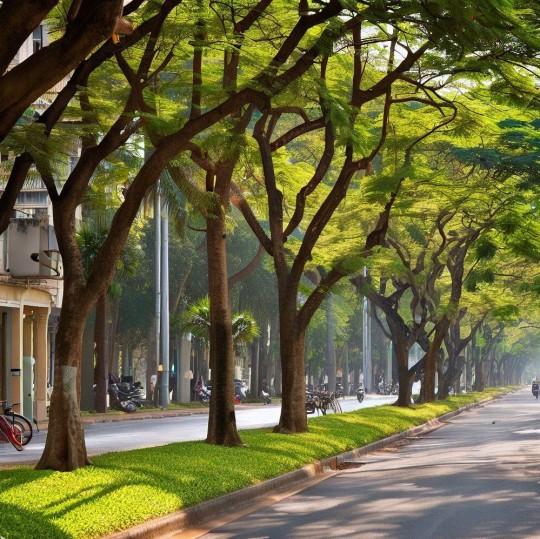
In summary, street-side trees are not just a decorative element but a proper green infrastructure that improves the quality of urban life. Therefore, It is vital to encourage planting, caring for, and preserving trees in urban areas, with the participation of government institutions, businesses, and residents, in order to achieve a shared vision to promote sustainable progress.
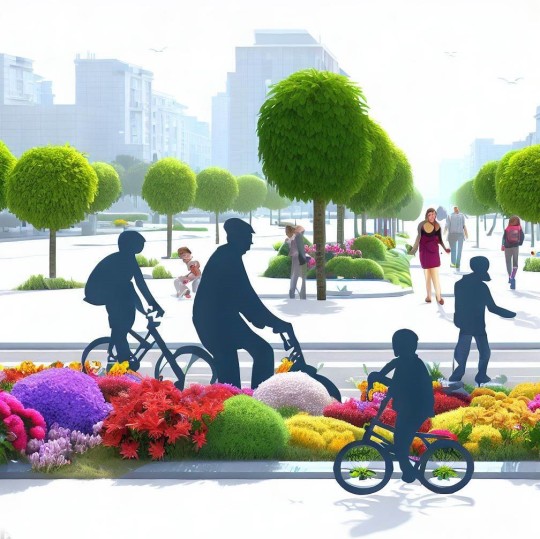
🟠 Italiano
Intro
Gli alberi sono elementi essenziali per creare paesaggi urbani attraenti e accoglienti, che favoriscono il benessere psicologico e sociale dei cittadini. contribuiscono a ridurre la temperatura e l'umidità dell'aria, mitigando gli effetti delle ondate di calore e del riscaldamento globale. Essi sono testimoni della storia, della cultura e dell'identità delle città, che conservano e trasmettono alle generazioni future. Alleati nella lotta ai cambiamenti climatici, oltre alla loro innegabile bellezza offrono una serie di benefici locali che spesso tendiamo a trascurare (al di là dei benefici globali di assorbimento dell’anidride carbonica). Questo articolo quindi ha lo scopo di sensibilizzare i lettori sull'importanza degli alberi per le città e per il pianeta, invitandoli a conoscere, apprezzare e tutelare il patrimonio arboreo urbano coinvolgendo i cittadini e le istituzioni in un processo partecipativo e responsabile.
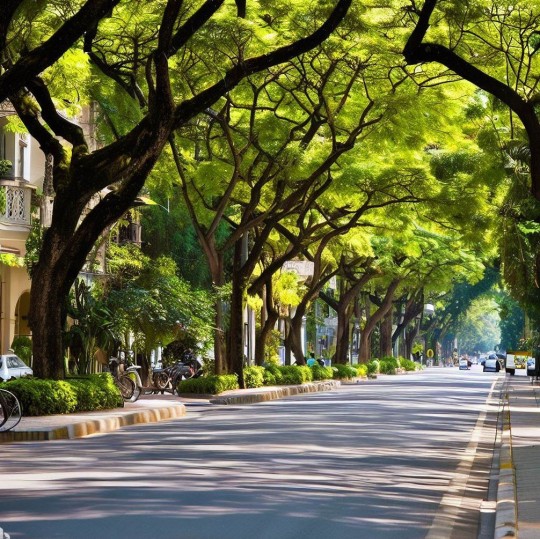
La magia degli alberi lungo le strade. Bellezza, frescura e prosperità urbana.
Gli alberi sono una risorsa preziosa per le città, non solo per il loro contributo alla mitigazione dei cambiamenti climatici, ma anche per i molteplici benefici che apportano alla salute, al benessere e alla qualità della vita dei cittadini. In questo articolo del Monocolo gli autori Paolo Massi e Giulia Papaleo, vogliono illustrare alcuni dei principali vantaggi che gli alberi offrono alle aree urbane e alle persone che le abitano. La magia degli alberi lungo le strade. Bellezza, frescura e prosperità urbana

La magia degli alberi lungo le strade dunque non si limita alla loro estetica. Gli alberi sono elementi essenziali per il benessere e lo sviluppo delle città, in quanto svolgono funzioni ecologiche, sociali ed economiche. Tra i vantaggi che gli alberi apportano all'ambiente urbano, possiamo citare:
Riduzione dell'inquinamento atmosferico: gli alberi catturano le particelle sospese nell'aria, filtrano i gas nocivi e producono ossigeno.
Mitigazione del cambiamento climatico: gli alberi assorbono il carbonio dall'atmosfera e lo immagazzinano nel loro legno, contribuendo a ridurre l'effetto serra.
Regolazione termica: gli alberi creano ombra e rinfrescano l'aria attraverso la traspirazione, diminuendo la temperatura e il consumo energetico per il raffreddamento degli edifici.
Conservazione del suolo e dell'acqua: gli alberi riducono l'erosione del suolo, aumentano la sua capacità di infiltrazione e ritardano il deflusso delle acque piovane, prevenendo le inondazioni e migliorando la qualità dell'acqua.
Incremento della biodiversità: gli alberi offrono rifugio e cibo a molte specie animali e vegetali, arricchendo la diversità biologica delle città.
Valorizzazione del paesaggio urbano: gli alberi creano scenari naturali, armonizzano l'architettura, attenuano il rumore e aumentano il valore immobiliare delle proprietà.
Promozione della salute e del benessere umano: gli alberi favoriscono la salute fisica e mentale delle persone, stimolando l'attività fisica, riducendo lo stress, migliorando l'umore e la concentrazione.
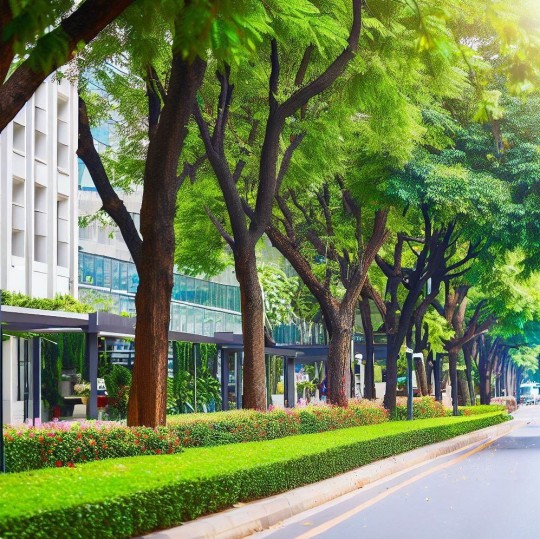
Gli alberi e le aiuole a verde lungo le strade sono quindi una risorsa preziosa per le città e i loro abitanti. Per questo motivo, è importante proteggerli, curarli e incrementarli, attraverso politiche pubbliche e azioni private che ne riconoscano il ruolo fondamentale per la qualità della vita urbana affinché la manutenzione, che sviluppa posti di lavoro, in particolare venga 'garantita' nel tempo.
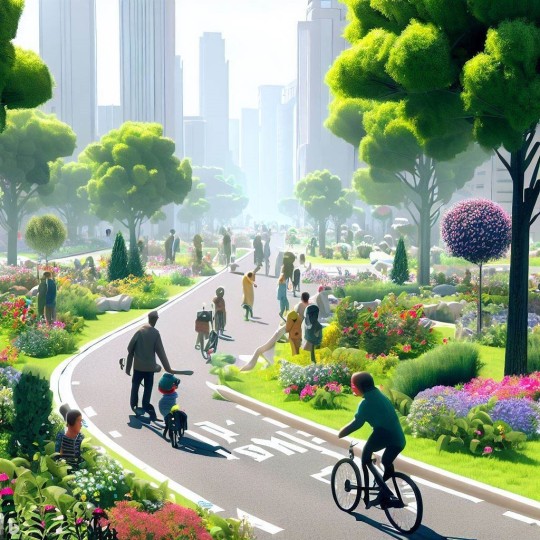
La forestazione urbana e gli ecoquartieri
Con il termine forestazione urbana si intende la progettazione e lo sviluppo di aree verdi urbane e periurbane, facendo della natura un'importante protagonista di questo paesaggio. Chiaramente è importante non solo progettare e sviluppare nuove aree verdi, ma anche rivalorizzare e riappropriarsi di quelle esistenti.
Certo! Gli ecoquartieri sono un esempio di ambienti urbani sostenibili e vivibili. Sono quartieri costruiti nel rispetto dell’equilibrio ambientale e della salute delle persone che vi abitano. Sono conformi ai principi della sostenibilità e puntano alla valorizzazione del patrimonio paesaggistico ed economico del contesto urbano in cui sono inseriti. La progettazione di un quartiere ecosostenibile punta a ridurne l’impatto ambientale: dalla fase di costruzione, al ciclo di vita, fino alla sua dismissione, senza mai dimenticare il comfort di chi lo vive. Si tratta di vere e proprie porzioni di città edificate con l’obiettivo di innalzare il livello di qualità della vita e sono realizzate ponendo l’accento su: risparmio energetico; uso delle energie rinnovabili e di materiale ecologico; riduzione del consumo di acqua e di rifiuti; promozione della mobilità sostenibile.
Inoltre, la forestazione urbana è un altro esempio di come gli ambienti urbani possono essere resi più vivibili e sostenibili. Le alberature stradali, i giardini e i parchi urbani rappresentano degli elementi di natura che contribuiscono a purificare l’aria che respiriamo, catturando sostanze inquinanti, immagazzinando carbonio e mitigando il clima delle città.
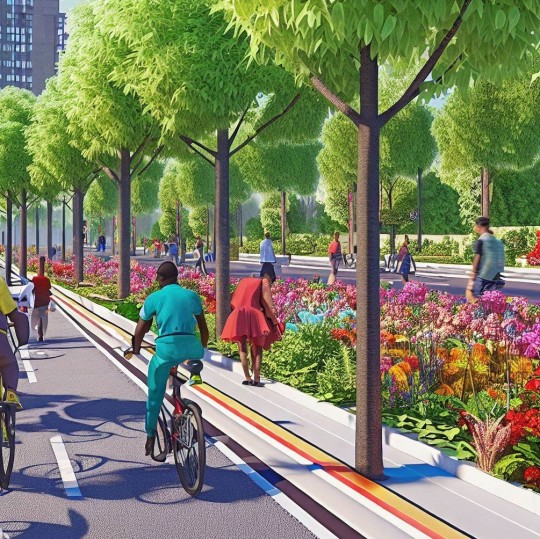
Come si può notare, gli alberi lungo le strade non sono solo un elemento decorativo, ma una vera e propria infrastruttura verde che migliora la qualità della vita urbana. Per questo motivo, è importante promuovere la piantumazione, la manutenzione e la protezione degli alberi nelle città, coinvolgendo le amministrazioni pubbliche, le imprese e i cittadini in una visione condivisa di sviluppo sostenibile.
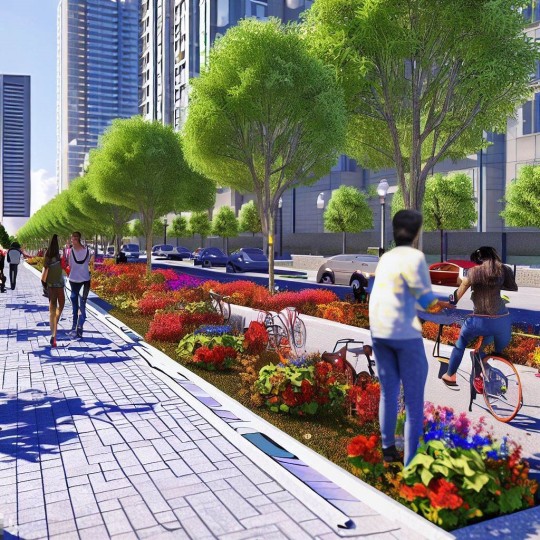
images created by The Board Behind © 2023
More related topics on this matter you might like:
Landscape Architecture: self-reflection on improving and enhancing our cities' run-down suburbs. English /Italian
Give color to the city to celebrate the joy of living.
I appreciate your kind presence and attention on this matter. Thank you for joining us today.
⏩ The Board Behind
#the board behind#sviluppo sostenibile#urban environments#urban tree heritage#ecological restoration#social growth#economic growth#city development#well being#urban living#urban life#heat wave#heat islands#sustainable progress#social innovation
11 notes
·
View notes
Text
"India’s announcement that it aims to reach net zero emissions by 2070 and to meet fifty percent of its electricity requirements from renewable energy sources by 2030 is a hugely significant moment for the global fight against climate change. India is pioneering a new model of economic development that could avoid the carbon-intensive approaches that many countries have pursued in the past – and provide a blueprint for other developing economies.
The scale of transformation in India is stunning. Its economic growth has been among the highest in the world over the past two decades, lifting of millions of people out of poverty. Every year, India adds a city the size of London to its urban population, involving vast construction of new buildings, factories and transportation networks. Coal and oil have so far served as bedrocks of India’s industrial growth and modernisation, giving a rising number of Indian people access to modern energy services. This includes adding new electricity connections for 50 million citizens each year over the past decade.
The rapid growth in fossil energy consumption has also meant India’s annual CO2 emissions have risen to become the third highest in the world. However, India’s CO2 emissions per person put it near the bottom of the world’s emitters, and they are lower still if you consider historical emissions per person. The same is true of energy consumption: the average household in India consumes a tenth as much electricity as the average household in the United States.
India’s sheer size and its huge scope for growth means that its energy demand is set to grow by more than that of any other country in the coming decades. In a pathway to net zero emissions by 2070, we estimate that most of the growth in energy demand this decade would already have to be met with low-carbon energy sources. It therefore makes sense that Prime Minister Narendra Modi has announced more ambitious targets for 2030, including installing 500 gigawatts of renewable energy capacity, reducing the emissions intensity of its economy by 45%, and reducing a billion tonnes of CO2.
These targets are formidable, but the good news is that the clean energy transition in India is already well underway. It has overachieved its commitment made at COP 21- Paris Summit [a.k.a. 2015, at the same conference that produced the Paris Agreement] by already meeting 40% of its power capacity from non-fossil fuels- almost nine years ahead of its commitment, and the share of solar and wind in India’s energy mix have grown phenomenally. Owing to technological developments, steady policy support, and a vibrant private sector, solar power plants are cheaper to build than coal ones. Renewable electricity is growing at a faster rate in India than any other major economy, with new capacity additions on track to double by 2026...
Subsidies for petrol and diesel were removed in the early 2010s, and subsidies for electric vehicles were introduced in 2019. India’s robust energy efficiency programme has been successful in reducing energy use and emissions from buildings, transport and major industries. Government efforts to provide millions of households with fuel gas for cooking and heating are enabling a steady transition away from the use of traditional biomass such as burning wood. India is also laying the groundwork to scale up important emerging technologies such as hydrogen, battery storage, and low-carbon steel, cement and fertilisers..."
-via IEA (International Energy Agency), January 10, 2022
Note: And since that's a little old, here's an update to show that progress is still going strong:
-via Economic Times: EnergyWorld, March 10, 2023
#india#solar power#renewable energy#green energy#sustainability#wind power#population grown#economic growth#developing economies#renewable electricity#carbon emissions#good news#hope#hope posting
856 notes
·
View notes
Text
Build yourself a sustainable routine for 2024
you don’t have to schedule all your habits for everyday. Some habits can be for twice a week or thrice a week. If you can’t read 10 pages everyday, don’t fret. Try to read 1 chapter a week. Then slowly progress to 2.
do not be intimidated by accounts like mine. I post a lot of tips but I follow only the ones I know work for me, even if those tips are great. I share a lot so that different people can make use of them. Just because tip A works better for me than tip B, doesn’t mean that tip B is useless. Someone else could find B more useful than A.
How do you know you’re building a sustainable routine?
here are some indicators:
⭐️ the habits are “portable” for the most part - you do not need to be in specific places to execute them (you can read anywhere, you can workout in any hotel, etc).
⭐️ you’re able to follow all your habits at least 80% of the time in a month. Which means out of 30 days, for 24 days you are able to follow your habits.
⭐️ they don’t stress you out. It doesn’t make sense to procrastinate over your habits. The point of the habits is to reduce procrastination and improve yourself. If you’re stressing over it, go back to square one and start small.
⭐️ you are able to see that you’re improving. Maybe you’re feeling more confident, self assured and resilient. Whatever your end goal, it is important to understand that you won’t go from being, for example, under confident to confident overnight. It will happen gradually. Noticing your progress and complimenting yourself for the gradual change is important because then you’re validating yourself for the healthy changes you make. When you validate yourself as opposed to someone else validating you, you are acknowledging the hard work you have put in- this increases your motivation to do even better and to stay disciplined.
⭐️ over time, the habits come to you naturally. Let’s say meditating. You become so used to meditating that not doing it is like not brushing your teeth in the morning. It becomes a part of you and you accept and embrace it instead of dreading it.
⭐️ yes, you will have tough days. You will have days where you want to give up. It is important to schedule at least 2 mental health days a month for yourself where you can choose to do absolutely nothing and just relax. You are human, not a machine. Sometimes you need to push through those tough days and get things done anyway. There is a balance between resting and working hard.
⭐️ you eventually do not feel guilt or shame for prioritising yourself and your routine first. This is the most important indicator. You do not put any boy, friend, anyone (unless it’s an emergency of course) above you. You know you are your most important person.
#c suite#powerful woman#ceo aesthetic#strong women#personal growth#that girl#productivity#getting your life together#balance#Routine#how to create a routine#Sustainable routine
639 notes
·
View notes
Text
Look at me. LOOK at me. Old growth forests are important. Their loss is violence against the land.
BUT that isn’t a reason to point at younger, perfectly healthy closed canopy forests and claim they’re ecologically insignificant or bad. Their sparse understory is a function of closed canopy forests. Even old growth forests will have sparse understories if the canopy is closed. That’s how photosynthetic strata works.
The west coast has vastly different forests and history than the east. The rare volcanic eruption that made the giant stands of Douglas fir in the west possible would be literally impossible here. Our species are adapted for stand replacing fires set by indigenous peoples to drive deer and rejuvenate oak. Oak as a genus is dying here. We can’t set fires. We can’t harvest patches large enough to simulate a fire. Our deer are overpopulated and browse down every sprout that dares to reach for sunlight.
Making a sweeping ban on clear-cut and similarly ‘scary’ harvests would kill them for good. The restrictions on fire have nearly done that to species like Jack and pitch pine that rely heavily on fire to establish. They’ve been relegated to pine barrens and the rare sandy forest clearing. Our fire Cherry, thankfully, can last decades in the soil seedbank. You can only see them the first few decades after a large, complete harvest and then they die.
What’s good for one forest kills another. Not all trees are made ecologically equal - and that’s a very good thing. All trees and forests have their ecological value. Management of one forest is never applicable to other forests; they all have their own unique histories and communities that should be imitated when possible and left alone when not.
#ra speaks#personal#forest#forestry#I wanna agree w old growth forest folks so bad but then they turn around and say shit like ‘there is NEVER a good reason to clearcut’#babes the kirt warbler would like to argue. bitches need 10-15 ft Jack pine to nest in. they’re picky.#you ain’t getting 10-15 ft Jack pine without a large. stand replacing. disturbance.#*shaking Californians by the shoulders* THERE IS MORE FOREST TO THE WORLD THAN DOUGLAS FIR. WHY ARENT YOU PROTECTING THE CLIFFSIDE CEDARS?#we have cedars on this coast that are OLD GROWTH. nobody but weird tree ppl seem to care bc THEYRE UGLY AF AND SMALL.#that doesn’t mean they’re ‘not old growth’#gosh do NOT even get me started on the semantics of old growth#and like. yeah we can’t replace old growth in the west BUT NOT BC PLANTATIONS HAVE A HARVEST SCHEDULE.#it’s because the original old growth only exists bc a VOLCANIC ERUPTION wiped out most everything else and laid a nice bed of ash#for the seedlings to establish in. id rather a shitty plantation keep a 50-60 ur harvest schedule on a single piece of land#than have them slowly chip away at literally irreplaceable trees in the name of#‘sustainable forestry’ babe there is no sustaining the western old growth. either a volcano decides to give it a fresh start or not#I hate hate hate the eternal-ness ppl have attached to forests they are not here for you they aren’t even here for species that rely on them#they’re here bc a long time ago nothing else was. they’re here bc the soil was just right. they’re here bc the people before respected that#but also understood their power to shape the landscape. and in doing so they created diversity rarely seen this far north.#sorry. it’s been a day. needed a good rant.
16 notes
·
View notes
Text

here they come.
#fern#ferns#fiddleheads#hay scented fern#nature#soothing#growth#wild plants#plants#greenery#rural life#rural living#rural lifestyle#homesteading#woodscore#naturecore#forestcore#sustainable living#cottagecore#the outdoors#slowloved#evolve#keep growing#unfurl#home#woods#forest#maine#new england#living in the woods
158 notes
·
View notes
Text
This is your sign to go through your closet as the seasons shift. 🌞 Remember to donate. Local thrifts/consignment shops are better than chains.
7 notes
·
View notes